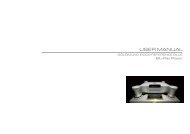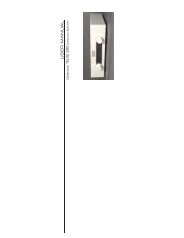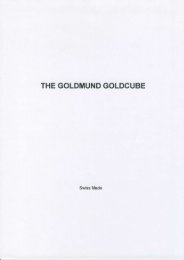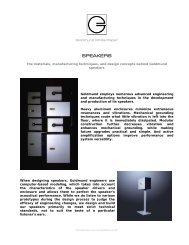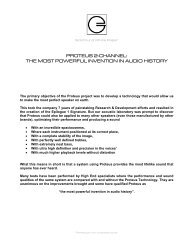MECHANICAL GROUNDING - Goldmund
MECHANICAL GROUNDING - Goldmund
MECHANICAL GROUNDING - Goldmund
You also want an ePaper? Increase the reach of your titles
YUMPU automatically turns print PDFs into web optimized ePapers that Google loves.
An Interesting Experience<br />
<strong>Goldmund</strong> White Paper<br />
<strong>MECHANICAL</strong> <strong>GROUNDING</strong><br />
Since the <strong>Goldmund</strong> T3 tone arm and the<br />
<strong>Goldmund</strong> Reference turntable, all <strong>Goldmund</strong><br />
products have been studied with extreme care<br />
for their mechanical parameters. Our lines of<br />
amplifiers and preamplifiers are mechanically<br />
built using the same principle:<br />
The <strong>Goldmund</strong> Mechanical Grounding principle.<br />
Developed by the <strong>Goldmund</strong> research<br />
engineers by analogy with the electrical<br />
grounding laws, this technology aims to a<br />
perfect suppression of spurious mechanical<br />
resonance in audio components by connecting<br />
rigidly their structure to a perfect mechanical<br />
ground: the earth. Just like electrical<br />
grounding, experiences have proven that only<br />
earth can sufficiently absorb vibration<br />
potential to secure the vibration level to zero.<br />
To easily explain the principle of the Mechanical Grounding, <strong>Goldmund</strong> usually presents the<br />
example of the electrical razor.<br />
When you hold an electrical razor, you perfectly feel the vibration of the unit. If you want to<br />
cancel those vibrations, you may try to damp it by applying soft, absorbing material around the<br />
razor. But wrapped in rubber or soft towels, the razor still vibrates, even if you do not feel it as<br />
strongly: the damping isolates the vibration, it doesn’t suppress it. Now, if you gently press the<br />
wrapped razor on the side of your tub, and the tub is strongly sealed t the building, attached itself<br />
to earth, the vibration will be greatly attenuated, like “evacuated” to the earth by the rigid<br />
connection you established.<br />
“Perfection in an imperfect world”
An Electrical Analogy<br />
This phenomenon is absolutely similar to the electrical grounding. When part of an electrical<br />
component is floating, the noise, hum and DC offset is not stable. The chassis “vibrates”. By<br />
coupling the chassis to the earth, you stabilize it and avoid potential vibrations. The thicker the<br />
wire that connects earth to the chassis is, the better the grounding will be.<br />
When the chassis is so grounded, any potential generated inside the unit, being relative to ground,<br />
is fixed, and the signals are much cleaner. In a similar way, small mechanical movements (such<br />
as the cartridge following the groove) are much cleaner in a mechanically grounded component.<br />
Drivers in a speaker do not loose part of their energy to make the enclosure vibrate; they have an<br />
“absolute fixed reference” and can provide much higher dynamics.<br />
An Optical Analogy<br />
To properly evacuate vibrations, the connection between the various elements of the mechanical<br />
structure must have certain properties. Vibrations can be “reflected” from one material to the<br />
other if some precise characteristics of the materials are not respected.<br />
The optical analogy with light transmission in an optical system produces very interesting<br />
similarities:<br />
When light travels from the air into a piece of glass, part of the light is reflected. Between two<br />
pieces of glass, the proportion of reflection depends on the surface and on the optical<br />
characteristics of the two types of glass. If the surface is finely polished and the two pieces are<br />
made of the same kind of glass (same refraction factor), the reflection is minimal. Light travels<br />
better from slow material (high refraction, slower propagation speed of the light) to fast material<br />
(low refraction).<br />
In mechanics, vibrations also can be reflected and not transmitted depending of the surface and<br />
kind of material. Instead of refraction factor, mechanical engineers are talking about mechanical<br />
impedance. As for optics, a vibration is easily transmitted from a slow material (soft, with slow<br />
propagation speed), to a fast material (hard, fast propagation speed). The <strong>Goldmund</strong> cone<br />
material has been designed using this analogy, including the selection of its angle (the “limit<br />
refraction angle” in optics).<br />
The Coloration in Audio Components<br />
The intensive study of several kinds of audio components made by the <strong>Goldmund</strong> engineers have<br />
proved that most of the audio sonic colorations are due to mechanical vibrations.<br />
If this effect is quite evident for components like speakers or cartridges, the recent research<br />
made by <strong>Goldmund</strong> on electronics mechanical vibrations is less known.<br />
As for a speaker enclosure that “vibrates”, generating frequency emphasis by re-emission, and<br />
transient blurring by energy absorption, mechanical parts of an electronic circuit, including the<br />
components themselves, can vibrate and generate spurious signal and coloration (usually by<br />
microphonic effect).<br />
The effect is very audible in electronic tubes. When the metallic parts vibrate (and they do when<br />
the voltage applied is modulated by the signal), the resonance of the electrodes themselves<br />
becomes audible, increasing decay time of the signal (the nice “spatial effect” of tubes), and<br />
coloring the signal in some frequency bands depending on the mechanical construction of the<br />
tube (difference between a “good” and a “bad” tube).<br />
“Perfection in an imperfect world”
The effect has also been detected in the past years in capacitors. The so-called “sonic fingerprint”<br />
of capacitors is mostly due to internal vibrations generated inside the capacitors between foils.<br />
The stronger the mechanical assembly is (film and foil Vs electrolytic), and the more “euphonic”<br />
the material resonance is (polystyrene Vs polycarbonate), the “better” the capacitor is for<br />
audiophiles. Thicker dielectric (high voltage) sounds better than finer. Solid aluminum electrolytic<br />
components are used rather than liquid vibrating electrolytic ones, etc…<br />
In an amplifier, the output transistors also generate high levels of vibrations and the <strong>Goldmund</strong><br />
amplifiers have started isolating those mechanically from the input circuitry which can capture the<br />
vibrations by the microphonic effect of input transistors.<br />
Mechanical grounding in speakers and turntables can also be improved by a more careful<br />
application of the same principles.<br />
A Good Mechanical Grounding Design<br />
Even if most of the technologies developed by <strong>Goldmund</strong> to mechanically ground its line of<br />
products are patented, the general principles to apply in order to obtain a good coupling with the<br />
earth are well known and used in other industries like in the big machine tools construction (a<br />
very important industry in Switzerland).<br />
Again, they can be very easily deducted from the electrical and optical analogies.<br />
First the mechanical coupling between the component and the earth must be very rigid (thick wire)<br />
otherwise the coupling material itself can resonate and act as a filter (un-damped cones). It will<br />
also transfer less energy (fine wire) and the evacuation of vibrations won’t be perfect.<br />
More, vibrations do travel better from slower material to faster material as we have seen. Proper<br />
selection of materials going from the slower to the faster ensures perfect evacuation and some<br />
limitation of vibration “re-entry” in the component. This effect has been called by <strong>Goldmund</strong> the<br />
“Mechanical Diode” effect. As seen in the optical analogy, the angles of the different mechanical<br />
parts attached together have some effect on this capability of directionality. It is interesting to<br />
notice that the cone is the shape used to represent a diode in electronics…<br />
Conical feet, mechanical diodes, strong and heavy materials for all chassis and evacuation pods,<br />
damping of the materials where the vibrations are transmitted are obvious in the design of<br />
<strong>Goldmund</strong> products.<br />
The Sonic Results of Mechanical Grounding<br />
The two significant effects of a good Mechanical Grounding on sound are:<br />
• Better dynamics.<br />
• Lower coloration.<br />
We have explained above that the Mechanical Grounding of any component is stabilizing its<br />
energy level relative to earth. Mechanically grounded speakers will use all the energy to move the<br />
cones in relation to the building (i.e. the listener). All available energy will be transformed into<br />
acoustical energy. Dynamics will be much improved. The same effect can be expected from a<br />
similar Mechanical Grounding design for an amplifier. Less internal resonance will produce a<br />
cleaner signal with a much more dynamic impact of the transients.<br />
The lower coloration is less easy to detect for an inexperienced listener, but it can be the most<br />
important benefit of a good Mechanical Grounding design. Lower coloration is what makes an<br />
“Perfection in an imperfect world”
audio component transparent and detailed. It allows a better distinction of subtle nuances and is<br />
also the key to good spatial phase accuracy.<br />
Considering the level of improvement <strong>Goldmund</strong> has been able to achieve by only implementing<br />
Mechanical Grounding in its components, it should be no further doubt that components not built<br />
taking it into account cannot be sonically accurate.<br />
Bibliography:<br />
• Daniel J Inman : Engineering Vibration<br />
• James F.Doyle : Wave Propagation in structures<br />
“Perfection in an imperfect world”



